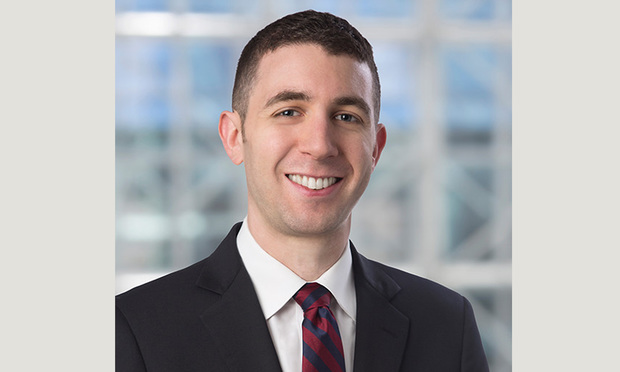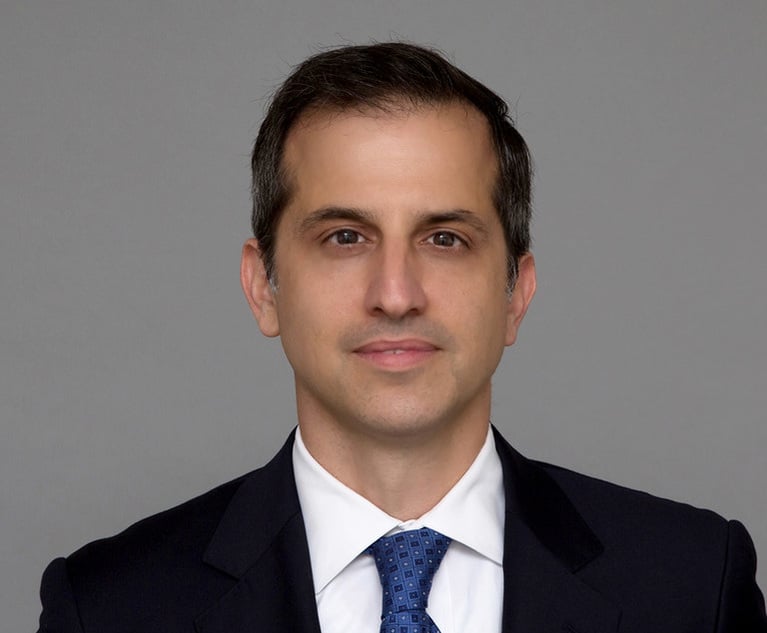Litigator of the Week: The 33-Year-Old Hogan Lovells Associate Who Scored a Comeback Win for Asylum Seekers
Reich helped convince a federal judge in Washington, D.C. to do an about-face and find Trump officials violated the Administrative Procedure Act by not following the law's "notice-and-comment" requirement before enacting a new asylum rule.
July 09, 2020 at 09:10 PM
9 minute read
 Mitchell P. Reich senior associate with Hogan Lovells.
Mitchell P. Reich senior associate with Hogan Lovells.
It would have been hard to blame Mitchell Reich of Hogan Lovells for being skeptical of his chances of persuading U.S. District Judge Timothy Kelly to block a Trump administration policy disqualifying individuals from seeking asylum in the U.S. unless they already sought similar protection in another country first. Kelly, a Trump appointee to the Washington, D.C. district court bench, had already denied a request for a temporary restraining order last year challenging the policy, which all but eliminated the possibility of asylum for refugees fleeing Central America through Mexico.
But on July 1, Kelly did an about-face and granted summary judgment to Reich and his clients finding Trump officials violated the Administrative Procedure Act by not following the law's "notice-and-comment" requirement before enacting the rule. It was an especially sweet win for Reich, an appellate specialist who had handled oral argument on the TRO loss and the summary judgment motion for clients: Capital Area Immigrants' Rights (CAIR) Coalition, Human Rights First, Refugee and Immigrant Center for Education and Legal Services (RAICES), and nine individual asylum seekers.
The win follows a string of impressive results this year for the 33-year old senior associate. Reich, who clerked for Justice Elena Kagan at the U.S. Supreme Court and Chief Judge Merrick B. Garland at the D.C. Circuit, won his first U.S. Supreme Court case in a unanimous decision in February in a tax case. On top of that, Reich, who was the first openly gay president of the Harvard Law Review, saw an amicus brief he co-authored referenced in one of this SCOTUS term's blockbusters, Bostock v. Clayton County, where the court found that Title VII of the Civil Rights Act prohibits employment discrimination based on sexual orientation or gender identity.
Lit Daily: Who is your client and what was at stake?
Mitchell Reich: We represent three immigrant legal services organizations—CAIR Coalition, RAICES, and Human Rights First—and a group of individual asylum-seekers who fled to the United States after enduring devastating violence and abuse in their home countries. Together we were challenging a federal policy that barred anyone from seeking asylum after crossing the southern border unless they sought and were denied relief in another country first. Given that Mexico's asylum system is broken and rife with abuse, this policy was accurately referred to in the press as an "asylum ban," and it represented the most drastic curtailment of asylum since the modern asylum system was put in place after World War II.
How did you and the Hogan Lovells team get involved?
Hogan Lovells has represented asylum-seekers for decades, going back to the firm's work representing Central American refugees in the 1980s. During the current Administration, this work has taken on new urgency: Before this case, we brought suits successfully challenging the travel ban, the family separation policy, and a previous iteration of this asylum ban. In several of those cases, we worked closely with CAIR Coalition, RAICES, and Human Rights First, three outstanding organizations that provide life-or-death assistance to some of the world's most vulnerable people.
When this policy was announced a year ago, my colleague Tom Schmidt and I read the rule, the underlying statute, and some relevant case law. Within an hour, we agreed the policy was flagrantly illegal. We told firm leadership we wanted to work with our clients to challenge it, and they immediately agreed. About 24 sleepless hours later, we filed a complaint, a brief, and a motion for a temporary restraining order in federal district court. In addition to me and Tom, the team included Elizabeth Hagerty, Kaitlin Welborn, Michael West, Mohan Warusha-Hennadige, and Heather Briggs, and was supported by partners Neal Katyal, Craig Hoover, Justin Bernick, and T. Clark Weymouth All of them did amazing, tireless work on this case and were critical to our victory.
Your case was consolidated with a related case brought by the Tahirih Justice Center and several additional asylum seekers. What was your working relationship like with their counsel?
Partway through our case, Tahirih Justice Center and several individual asylum-seekers filed a related case in which they were represented by the ACLU and the National Immigrant Justice Center. The attorneys at both organizations are superb, and Julie Veroff at the ACLU did an exemplary job arguing the motion for summary judgment with me in district court. One of the joys of public interest litigation, at a firm or elsewhere, is that the work is collaborative and the cause is deeply felt, so there are many opportunities like this to work alongside brilliant and good-hearted people.
Your case has been playing out in parallel to another being heard in the Northern District of California and the Ninth Circuit? How does this decision in your case change the current lay of the land for asylum seekers?
Although a judge in the Northern District of California preliminarily enjoined this policy last July, that injunction was quickly stayed by the Supreme Court, so the policy remained in effect for nearly a year afterwards. The decision in our case immediately ended that—and because it is a final judgment vacating the rule, it's not subject to the Supreme Court's stay. A few days after the decision in our case, the Ninth Circuit upheld the preliminary injunction issued out in California. But while that too is a huge victory for asylum seekers, it alone has no immediate effect, because the Supreme Court's stay of that injunction remains in place pending appeal.
How did having the government's position laid out in the case playing out in California help you approach your own case?
The cases were litigated more or less simultaneously in both courts, so we saw the government's arguments in real time when it made them in our case. The main benefit of the California litigation was that it gave us the opportunity to see the reasoning of the judges and the arguments made by the plaintiffs (represented again by the ACLU) out west. It's no knock on either team to say that we happily borrowed their best arguments, and sometimes developed them and found new avenues of attack.
Before Judge Kelly sided with you on summary judgment he had denied your request for a temporary restraining order. What changed? Were you able to make some new arguments on summary judgment? Or did something on the ground change that made your arguments more persuasive this time around?
Losing the motion for a temporary restraining order was, at the time, a deeply disappointing setback. But going through that process had one large benefit: It gave me an opportunity to argue in front of Judge Kelly for four hours and learn in person which arguments landed, which he didn't buy, and where the government's arguments seemed weakest. We took his comments and questions at that oral argument extremely seriously, and were able to refine our arguments and focus on the aspect of the case that seemed to trouble him most: the government's extremely thin rationale for skipping notice and comment. The work we did developing that argument between the TRO hearing and the summary judgment hearing was, I think, the principal reason we won.
There's lots of talk in the profession about the growing scarcity of oral argument opportunities for associates. How have you been able to find and take advantage of your own opportunities for oral argument as a senior associate?
Two words: Neal and Cate. Neal Katyal and Cate Stetson, the co-directors of our appellate group, have put an extraordinary amount of time and capital into obtaining oral argument opportunities for the associates in our appellate group, to a degree that I think is unparalleled in any other firm. They enabled me to get my first big oral argument opportunity—in a televised Ninth Circuit argument against the travel ban, no less—and backed me and my former colleague Colleen Sinzdak (now at the Solicitor General's office) when we said we wanted to find cases of our own to take up to the Supreme Court. Equally important, they and firm leadership in general are willing to put Hogan's resources behind pro bono cases like this one, where opportunities for associates to argue are more plentiful.
More firms should take this approach. Finding and sharing argument opportunities isn't just a gift to associates, although it is that. It's also a powerful recruiting tool—the main reason I came to Hogan, in fact—and an even better way to encourage people to stick around. It makes for better lawyers and more sophisticated brief-writers. And because one oral argument tends to lead to the next, it helps produce lawyers who can start to stand on their own feet and become business generators in their own right.
You notched your first U.S. Supreme Court case earlier this year in a tax case and had an amicus brief that you co-wrote play a prominent role in Bostock v. Clayton County. Do you have something figured out about 2020 that you can clue the rest of us into? (I'm only half-kidding.)
When the history is written about 2020, we'll all remember—first and foremost—my victory in overturning the "Bob Richards rule" for allocating consolidated tax refunds.
What will you remember about this case?
Several months into this case, one of our clients—a woman who was raped and beaten for over a year by gang members, first in El Salvador and then in Mexico—was denied asylum and removed from the country. I wrote the notice informing the court of her removal, and I had to stop to collect myself more than once while drafting it. It's profoundly unjust that people like her were made to suffer because of this rule, and it will always be one of the great honors of my career to have played a part in bringing this policy to an end.
This content has been archived. It is available through our partners, LexisNexis® and Bloomberg Law.
To view this content, please continue to their sites.
Not a Lexis Subscriber?
Subscribe Now
Not a Bloomberg Law Subscriber?
Subscribe Now
NOT FOR REPRINT
© 2025 ALM Global, LLC, All Rights Reserved. Request academic re-use from www.copyright.com. All other uses, submit a request to [email protected]. For more information visit Asset & Logo Licensing.
You Might Like
View All
Firms Come Out of the Gate With High-Profile Litigation Hires in 2025

2024 Marked Growth On Top of Growth for Law Firm Litigation Practices. Is a Cooldown in the Offing for 2025?

Big Company Insiders See Technology-Related Disputes Teed Up for 2025

Litigation Leaders: Jason Leckerman of Ballard Spahr on Growing the Department by a Third Via Merger with Lane Powell
Law Firms Mentioned
Trending Stories
- 1ACC CLO Survey Waves Warning Flags for Boards
- 2States Accuse Trump of Thwarting Court's Funding Restoration Order
- 3Microsoft Becomes Latest Tech Company to Face Claims of Stealing Marketing Commissions From Influencers
- 4Coral Gables Attorney Busted for Stalking Lawyer
- 5Trump's DOJ Delays Releasing Jan. 6 FBI Agents List Under Consent Order
Who Got The Work
J. Brugh Lower of Gibbons has entered an appearance for industrial equipment supplier Devco Corporation in a pending trademark infringement lawsuit. The suit, accusing the defendant of selling knock-off Graco products, was filed Dec. 18 in New Jersey District Court by Rivkin Radler on behalf of Graco Inc. and Graco Minnesota. The case, assigned to U.S. District Judge Zahid N. Quraishi, is 3:24-cv-11294, Graco Inc. et al v. Devco Corporation.
Who Got The Work
Rebecca Maller-Stein and Kent A. Yalowitz of Arnold & Porter Kaye Scholer have entered their appearances for Hanaco Venture Capital and its executives, Lior Prosor and David Frankel, in a pending securities lawsuit. The action, filed on Dec. 24 in New York Southern District Court by Zell, Aron & Co. on behalf of Goldeneye Advisors, accuses the defendants of negligently and fraudulently managing the plaintiff's $1 million investment. The case, assigned to U.S. District Judge Vernon S. Broderick, is 1:24-cv-09918, Goldeneye Advisors, LLC v. Hanaco Venture Capital, Ltd. et al.
Who Got The Work
Attorneys from A&O Shearman has stepped in as defense counsel for Toronto-Dominion Bank and other defendants in a pending securities class action. The suit, filed Dec. 11 in New York Southern District Court by Bleichmar Fonti & Auld, accuses the defendants of concealing the bank's 'pervasive' deficiencies in regards to its compliance with the Bank Secrecy Act and the quality of its anti-money laundering controls. The case, assigned to U.S. District Judge Arun Subramanian, is 1:24-cv-09445, Gonzalez v. The Toronto-Dominion Bank et al.
Who Got The Work
Crown Castle International, a Pennsylvania company providing shared communications infrastructure, has turned to Luke D. Wolf of Gordon Rees Scully Mansukhani to fend off a pending breach-of-contract lawsuit. The court action, filed Nov. 25 in Michigan Eastern District Court by Hooper Hathaway PC on behalf of The Town Residences LLC, accuses Crown Castle of failing to transfer approximately $30,000 in utility payments from T-Mobile in breach of a roof-top lease and assignment agreement. The case, assigned to U.S. District Judge Susan K. Declercq, is 2:24-cv-13131, The Town Residences LLC v. T-Mobile US, Inc. et al.
Who Got The Work
Wilfred P. Coronato and Daniel M. Schwartz of McCarter & English have stepped in as defense counsel to Electrolux Home Products Inc. in a pending product liability lawsuit. The court action, filed Nov. 26 in New York Eastern District Court by Poulos Lopiccolo PC and Nagel Rice LLP on behalf of David Stern, alleges that the defendant's refrigerators’ drawers and shelving repeatedly break and fall apart within months after purchase. The case, assigned to U.S. District Judge Joan M. Azrack, is 2:24-cv-08204, Stern v. Electrolux Home Products, Inc.
Featured Firms
Law Offices of Gary Martin Hays & Associates, P.C.
(470) 294-1674
Law Offices of Mark E. Salomone
(857) 444-6468
Smith & Hassler
(713) 739-1250






